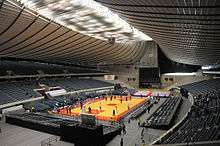Yoyogi National Gymnasium
| Yoyogi | |
 | |
| Location | 2-1, Jinnan, Shibuya, Tokyo, Japan |
|---|---|
| Public transit |
Tokyo Metro (at Meiji-jingumae): C Chiyoda Line F Fukutoshin Line JR East: JY Yamanote Line at Harajuku |
| Owner | Japan Sport Council |
| Capacity |
13,291 (1st Gymnasium) 3,202 (2nd Gymnasium) |
| Construction | |
| Broke ground | February 1963 |
| Opened | October 1964 |
| Architect | Kenzo Tange |
Yoyogi National Gymnasium (Japanese: 国立代々木競技場 Hepburn: Kokuritsu Yoyogi Kyōgi-jō) is an arena located at Yoyogi Park in Shibuya, Tokyo, Japan, which is famous for its suspension roof design.
It was designed by Kenzo Tange and built between 1961 and 1964 to house swimming and diving events in the 1964 Summer Olympics. A separate annex was used for the basketball competition at those same games. It will also host handball competitions at the 2020 Summer Olympics.[1] The design inspired Frei Otto's arena designs for the Olympic Stadium in Munich.[2]
The arena holds 13,291 people (9,079 stand seats, 4,124 arena seats and 88 "royal box" seats) and is now primarily used for ice hockey, futsal and basketball. Images of the arena are regularly featured at the end of NHK Newsline broadcasts because the NHK World studios are adjacent to the arena along the edge of Yoyogi Park.

Events
- The official 1971 Asian Basketball Championship for men
- The official 1982 Asian Basketball Championship for Women
- The official 2006 Women's Volleyball World Championship
- Since 2007: Foundation of Japan Cheerleading Association's (FJCA) Cheerleading Asia International Open Championships (CAIOC). 2012 will host the 6th edition from 18 to 20 May,[3] and is sanctioned by the International Federation of Cheerleading (IFC).[4]
- The official 2010 Women's Volleyball World Championship
- 25 and 26 January 2011: SMTown Live '10 World Tour by SM Entertainment.[5]
- 29 May 2014: Luna Sea performed their 25th anniversary concert.[6]
- 3 and 4 June 2017: Britney Spears performed two sold out concerts at the venue on her Britney: Live in Concert world tour.[7]
References
- ↑ "Venue Plan". Tokyo 2020 Bid Committee. Archived from the original on July 27, 2013. Retrieved 11 September 2013.
- ↑ Allison Lee Palmer (30 September 2009). The A to Z of Architecture. Scarecrow Press. p. 265. ISBN 978-0-8108-6895-3. Retrieved 3 December 2012.
- ↑ "イベント情報 代々木競技場第一体育館". Naash.go.jp. Retrieved 2012-03-05.
- ↑ "International Federation of Cheerleading". Ifc-hdqrs.org. Retrieved 2012-03-05.
- ↑ "SM artists to hold additional show for concert in Japan" Asiae. 23 June 2011. Retrieved 2011-03-21
- ↑ "LUNA SEA、バンド結成記念日に25周年ライブ実施". natalie.mu (in Japanese). 2013-12-04. Retrieved 2013-12-14.
- ↑ https://www.livenation.co.jp/show/961836/%E3%83%96%E3%83%AA%E3%83%88%E3%83%8B%E3%83%BC-%E3%82%B9%E3%83%94%E3%82%A2%E3%83%BC%E3%82%BA-live-in-concert/tokyo/2017-06-04/en
External links
- Official website (in Japanese)
- Sport facilities page on Japan Sport Council official English website
- 1964 Summer Olympics official report. Volume 1. Part 1. pp. 121–4.
- Olympic Arena – Great Buildings Online
- Yoyogi National Gymnasium at the archINFORM database.
| Preceded by Peace and Friendship Stadium Piraeus |
FIVB Volleyball Men's World Championship Final Venue 1998 |
Succeeded by Estadio Luna Park Buenos Aires |
| Preceded by Estadio Luna Park Buenos Aires |
FIVB Volleyball Men's World Championship Final Venue 2006 |
Succeeded by PalaLottomatica Rome |
| Preceded by Lake Charles Civic Center |
Ultimate Fighting Championship venue UFC 25 |
Succeeded by Five Seasons Events Center |
Coordinates: 35°40′03″N 139°42′01″E / 35.66750°N 139.70028°E
| Wikimedia Commons has media related to Yoyogi National Gymnasium. |



